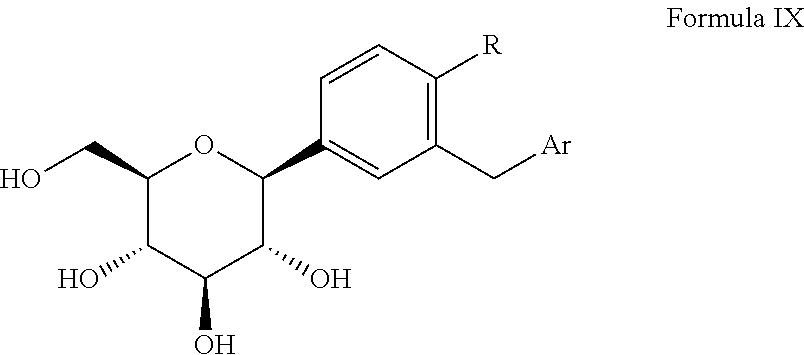Process for the preparation of SGLT inhibitor compounds
a technology of inhibitors and compounds, applied in the preparation of sugar derivatives, saccharide with carbocyclic radicals, sugar derivates, etc., can solve the problems of complex treatment of type 2 diabetes, aggravate hypertension, further impair insulin action, etc., and achieve the effect of convenient availability and cost-effectiveness
- Summary
- Abstract
- Description
- Claims
- Application Information
AI Technical Summary
Benefits of technology
Problems solved by technology
Method used
Image
Examples
example 1
Stage 1: Synthesis of (3R,4S,5R,6R)-3,4,5-tris(benzyloxy)-6-((benzyloxy)methyl)-2-(34(5-(4-fluorophenyl)thiophen-2-yl)methyl)-4-methylphenyl)tetrahydro-2H-pyran-2-ol
[0113]Charged water (175 ml) and sodium bicarbonate (14 gm) in RB flask (RBF) and stirred. It was cooled to 0 to 5° C. and 10% sodium hypochlorite solution (34.5 gm) was added. By maintaining the temperature between (0 to 5° C.), pH was adjusted with acetic acid to 7.0-7.5 (solution 1).
[0114]In another 500 ml 4 neck RBF, 2,3,4,6-tetra-O-benzyl-D-glucopyranose (25 gm, 0.0046 mol) dissolved in a 1:1 mixture of dichloromethane: toluene (150 ml) and charged water (50 ml). The compound 2,2,6,6-tetramethylpiperidine-1-oxyl (0.1 gm) was then added to this mixture. To the above solution, sodium hypochlorite solution (solution 1) was slowly added by maintaining the temperature between 10° C. to 15° C. The progress of the reaction was monitored by HPLC. After completion of the reaction, the reaction mixture was quenched by adding ...
example 2
Preparation of (2S,3R,4R,5S,6R)-2-(3-[(5-(4-flourophenyl)thiophene-2-yl)methyl]-4-methylphenyl)-6-(hydroxymethyl)tetrahydro-2H-pyran-3,4,5-triol [Canagliflozin]
[0119]In 4 neck RBF charged (3R,4R,5R,6R)-3,4,5-tris(benzyloxy)-6-(benzyloxymethyl)-2-(3-[(5-(4-fluorophenyl)thiophen-2-yl)-4-methylphenyl]tetrahydro-2H-pyran (50 gm, 0.0621 moles), dichloromethane (400 ml) and acetonitrile (300 ml), sodium iodide (100 gm, 0.667 moles), boron trifluoride-diethyl etherate (94.41 gm, 0.667 mole) at 25-30° C. along with acetonitrile (100 ml). The reaction mixture was stirred at room temperature for 4-5 hours. After reaction completion, the reaction mixture was quenched by 5% bicarbonate solution (400 ml) at 25-30° C. Separated the organic layer and aqueous layer was further extracted with dichloromethane (2×250 ml). Combined organic layer was washed with 5% thiosulfate solution and dried over anhydrous sodium sulphate. Filtered and the solvent was concentrated under reduced pressure. The residue...
example 3
In situ preparation of (2S,3R,4R,5S,6R)-2-(3-[(5-(4-flourophenyl)thiophene-2-yl)methyl]-4-methylphenyl)-6-(hydroxymethyl)tetrahydro-2H-pyran-3,4,5-triol [Canagliflozin]
[0120]In a 250 ml 4-neck RBF under nitrogen atmosphere charged (3R,4S,5R,6R)-3,4,5-tris(benzyloxy)-6-(benzyloxymethyl)-2-(3-((5-(4-fluorophenyl)thiophen-2-yl)methyl)-4-methylphenyl)tetrahydro-2H-pyran-2-ol (50 gm, 0.0609 mole) and dichloromethane (200 ml). The reaction mass was cooled to −30° C. and charged triethylsilane (28.66 ml, 0.181 mole) followed by a slow addition of boron trifluoride-diethyl etherate (24.00 ml, 0.191 moles) maintaining the temperature at −40° C. to 0° C. After the addition was complete the ice bath was removed and the resulting mixture was stirred at room temperature, for 1.0-2.0 hrs monitoring the reaction progress by TLC.
[0121]After reaction completion, sodium iodide (100 gm, 0.667 moles) and boron trifluoride-diethyl etherate (94.41 gm, 0.667 mole) were added to the reaction mass at 25° C....
PUM
| Property | Measurement | Unit |
|---|---|---|
| temperature | aaaaa | aaaaa |
| temperature | aaaaa | aaaaa |
| temperature | aaaaa | aaaaa |
Abstract
Description
Claims
Application Information
 Login to View More
Login to View More - R&D Engineer
- R&D Manager
- IP Professional
- Industry Leading Data Capabilities
- Powerful AI technology
- Patent DNA Extraction
Browse by: Latest US Patents, China's latest patents, Technical Efficacy Thesaurus, Application Domain, Technology Topic, Popular Technical Reports.
© 2024 PatSnap. All rights reserved.Legal|Privacy policy|Modern Slavery Act Transparency Statement|Sitemap|About US| Contact US: help@patsnap.com










